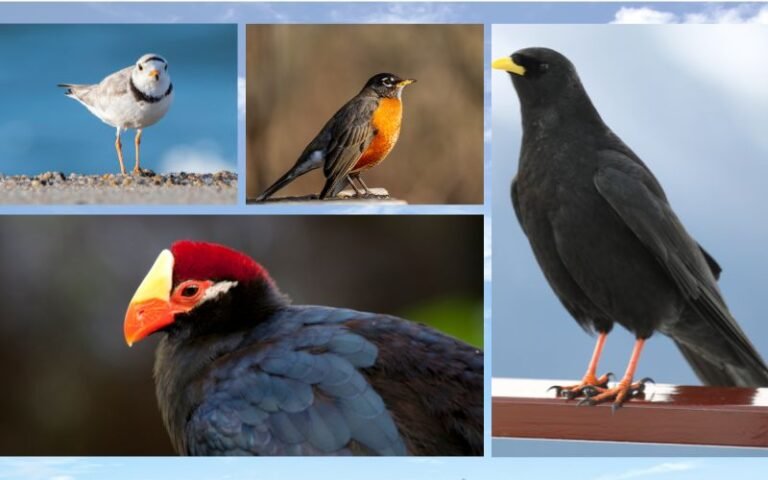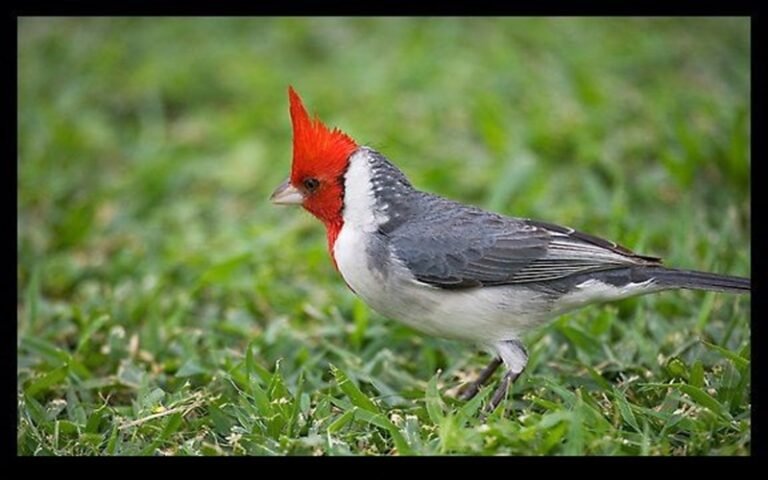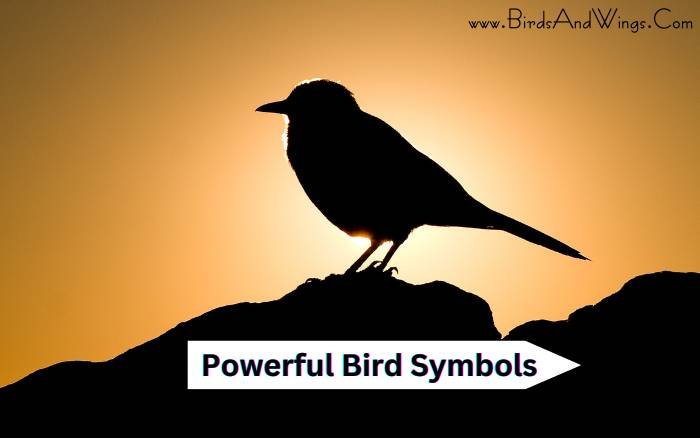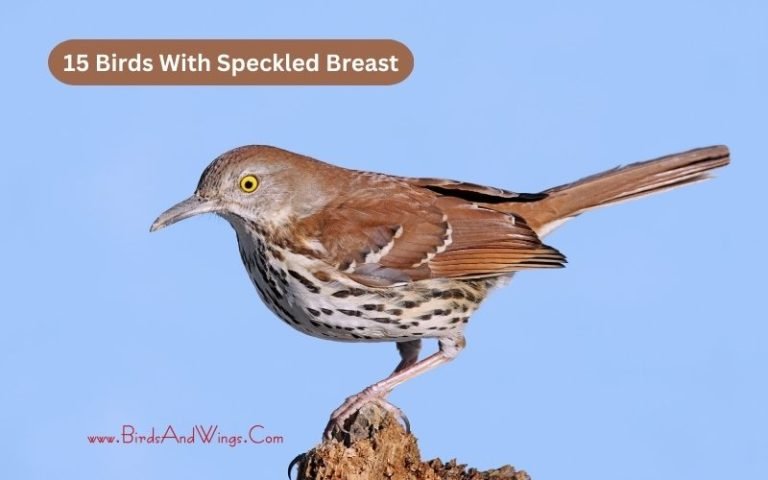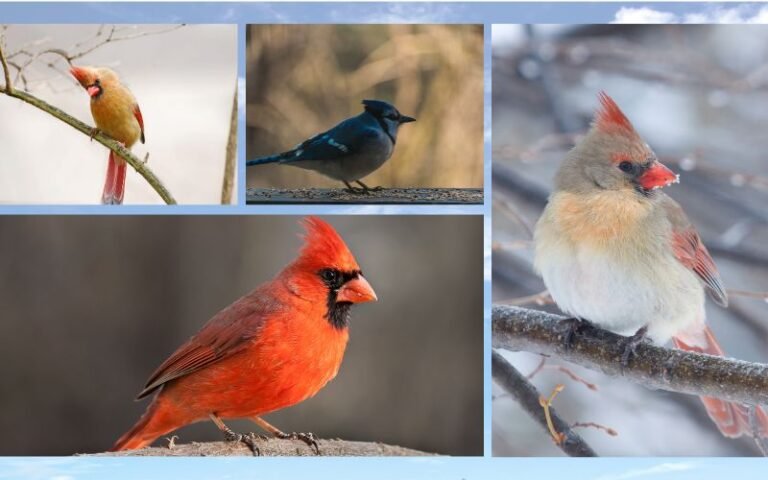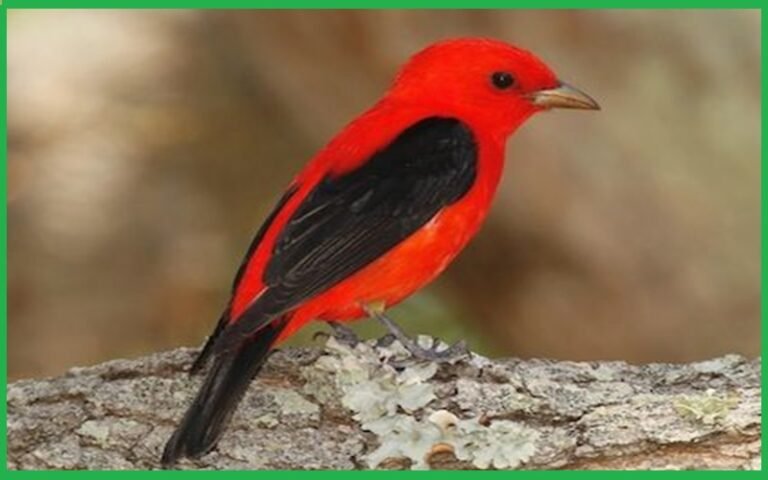Top 25 Beautiful Birds with Crest
Birds with crests have a significantly charismatic look over their avian species. Their distinct crests on the head look like a crown.
In this article, we will explore the top 25 Birds with crests, their characteristics, cultural significance, and symbolism of these birds, and understand their crest from a scientific point of view.
25 Birds with Crest
Let’s explore the top 25 birds with crests, their scientific names, life spans, native places, size, and other facts about them.
1. Steller’s Jay
Scientific name: Cyanocitta stelleri
Lifespan: around 16 years
Native to: North America
Size: 30 to 40 centimeters in length; 100-104 grams weight
Steller’s Jaybird is a blue bird with a crown crest and long tail. They eat seeds, cracked corn, fruits, eggs, etc. They have a special ability to detect their predators. They can imitate other birds’ vocal sounds and environmental sounds as well.
2. Blue Jay
Scientific name: Cyanocitta cristata
Lifespan: about 7 years
Native to: Eastern North America
Size: 22 to 30 cm
Blue Jay birds are aggressive and noisy birds. They show aggressiveness when seeing humans close to their nests or territory areas. They eat seeds, nuts, grains, fruits, peanuts, berries, etc. They prefer dense forests and woodlands for their habitats.
You can also read this post: Is blue Jay a sign of heaven?
3. Northern Cardinal
Scientific name: Cardinalis cardinalis
Lifespan: around 3 years
Native to: United States
Size: 21- 23 cm
Northern cardinals are regarded as red birds or common birds or red cardinals. During their breeding season, they are familiar with Canada, California, and New Mexico. They prefer woodland wooded areas for their habitats.
4. Tufted Titmouse
Scientific name: Baeolophus bicolor
Lifespan: around 2 years
Native to: North America
Size: 14-16 cm
Tufted Titmouse birds are small birds with grayish upper body parts, crests, and white belly. They are fond of mixed wooded areas, gardens, and parks for their habitats. They don’t build their nests; rather, they prefer tree holes, natural cavities, or man-made structures for their nesting.
5. Oak Titmouse
Scientific name: Baeolophus inornatus
Lifespan: around 2 years
Native to: North America
Size: 5 inch
Oak Titmouse birds are small birds with crests. They are familiar in California, West of Sierra Nevada. They are fond of wooded areas like woodlands, dry oak, and forests for their habitats. They sleep in their tree cavities. Their breeding season starts in April and May.
6. Cedar Waxwing
Scientific name: Bombycilla cedrorum
Lifespan: around 8 years
Native to: North and Central America
Size: 6 to 8 inches
The Cedar Waxwing bird is a small bird with a brownish body, crests, and black face. They are fond of forests, wooded places, and suburban areas for their habitats. Males and females pass an object through them during their courtship, and males perform a hopping dance during that time.
7. Pileated Woodpecker
Scientific name: Dryocopus pileatus
Lifespan: 9 to 12 years
Native to: North America
Size: 40 to 49 cm
A pileated Woodpecker is a large woodpecker with red crests on its head. They are familiar in Canada United States and prefer wooded parks and hardwood trees for their habitats.
8. Vermilion Flycatcher
Scientific name: Pyrocephalus obscurus
Lifespan: around 4 to 5 years
Native to: North and South America
Size: 13 to 14 cm
The vermilion flycatcher is a small bird with red crests on its head and brown wings. They are familiar in the southwestern United States. They prefer open areas, savanna, agricultural areas, and woodlands for their habitats.
9. Ruby Crowned Kinglet
Scientific name: Corthylio calendula
Lifespan: around 9 years
Native to: North America
Size: 9-11 cm
Ruby Crowned Kinglet is a small bird with an olive green body and a red crest on its head. They migrate to Canada, Australia, and Alaska during their breeding season. Their diet contains small insects, spiders, and berries.
10. Golden-crowned Kinglet
Scientific name: Regulus satrapa
Lifespan: around 6 to 7 years.
Native to: North America
Size: 8-11 cm
The Golden Crowned Kinglet is a small bird that has olive-gray plumage and golden crests on its head. They are migratory birds and travel throughout North America during their breeding seasons.
11. Indian Peafowl
Scientific name: Pavo cristatus
Lifespan: 15 years
Native to: India
Size: 39 to 45 inches (100 cm to 115 cm)
Indian Peafowl is a vibrant blue Peacock with blue crests on its head. They are familiar in the Indian subcontinent and also somewhere in Sri Lanka. They are mostly known for their feathers distribution during their courtship rituals. They eat worms, insects, fruits, small mammals, frogs, and reptiles.
12. Northern Lapwing
Scientific name: Vanellus vanellus
Lifespan: around 21 years
Native to: North Africa
Size: 28- 33 cm
Northern Lapwing birds are also regarded as Peewit or green Plover. The upper side of the body is shiny green, and the lower part is white with a long curved crest on its head. They are familiar in Northern India, Nepal, Bhutan, and China. They are aggressive to all intruders, especially horses and cattle.
13. Rockhopper Penguin
Scientific name: Eudyptes chrysocome
Lifespan: 10 years
Native to: North Antarctica, New Zealand
Size: around 22 inches
Rockhopper Penguin has a black and white body with large feet. It has straight plumage on its head which is its crest. They are also familiar in the Indian Ocean, Argentina, and southern America. Their diet has shrimp, crabs, lobsters, and crayfish.
14. Victoria Crowned Pigeon
Scientific name: Goura Victoria
Lifespan: 20 to 25 years
Native to: New Guinea
Size: 73 to 75 cm
Victoria Crowned Pigeon has vibrant blue feathers, reddish Irish, and crowned features on its head. They prefer lowlands, forests, and sago forests for their habitats. These species travel in pairs and search for food together. They mostly eat fruits from the ground.
15. Eurasian Hoopoe
Scientific name: Upupa epops
Lifespan: 5 to 10 years
Native to: Europe and Asia.
Size: 25 to 32 cm
Eurasian Hoopoe is a small bird with long beaks and distinctive long crests on its head. Their head and neck are brown. Their back and wings are dark brown with white lines. They eat insects, small reptiles, berries, seeds, and frogs for their food. Male hoopoe claims ownership of their territory during the breeding season.
16. Grey crowned crane
Scientific name: Balearica regulorum
Lifespan: around 20 to 30 years
Native to: Africa
Size: 3 ft 3 inch
Grey-crowned crane is a large bird with gray and black plumage over their body with long legs. They have yellow crests on their heads. They prefer savanna areas, sub-Saharan areas, mashes, and cultivated lands for their habitats.
17. Palm Cockatoo
Scientific name: Probosciger aterrimus
Lifespan: 40 to 60 years
Native to: New Guinea, Aru Islands, and Cape York
Size: 55 to 60 cm
Palm Cockatoo is a similar species of parrot. It is regarded as a great black cockatoo or Goliath cockatoo also. Their whole body is grayish black, and their cheeks are red with a long crest on their head.
They are fond of rainforests, dense forests, and woodlands for their habitats. This bird lays only one egg, so they are considered the lowest species with the lowest breeding success rate.
18. Crested Duck
Scientific name: Lophonetta specularioides
Lifespan: around 8 to 12 years
Native to: South America
Size: 6 to 7 pounds
The crested Duck is a subspecies of the duck family. They have white bodies and white cloudy crests on their heads. They build their nests around watery places.
19. Red-crested Turaco
Scientific name: Tauraco erythrolophus
Lifespan: around 9 years
Native to: Angola
Size: 45 to 50 cm
Red-Crested has shiny green and black plumage with a white face. They have a red crest on their head. They are mostly found in pairs or flocks. They mostly sit on a tree and come down to find food for them
20. Crested Caracara
Scientific name: Caracara plancus
Lifespan: over 30 years
Native to: South America
Size: 49 to 58 cm
Crested caracara birds have white and black plumage over their body. Their head has a black patch crested with an orange face and legs. They often walk on the open fields and grounds to search for food or prey.
21. Polish Chicken
Scientific name: Gallup domesticus
Lifespan: 7 to 8 years
Native to: Netherlands, Central and Eastern Europe
Size: 12 to 15 inches
Polish chickens have brown and black plumage covering their body. They also have half red beaks with crests on their heads. Their crests cover their vision. They eat seeds, fruits, and insects mostly found on the ground.
22. Cockatiel
Scientific name: Nymphicus hollandicus
Lifespan: 10 to 15 years
Native to: Australia
Size: 30 to 33 cm
The cockatiel bird is another parrot species with a crest on its head. Their face is lime green and round orange cheeks with a grayish body or white body.
They can mimic and imitate human voices or any environmental sounds. They have puzzle-solving skills, which make them intelligent species among other birds. They make their nests in tree hollows beside watery places.
23. Himalayan Monal
Scientific name: Lophophorus impejanus
Lifespan: 10 to 12 years
Native to: Himalayan
Size: about 70 cm
Himalayan Monal has vibrant color plumage on their body with a shiny blue, red, and metallic green combination. They have crests over their heads. They are also familiar in Pakistan, India, and Afghanistan for their habitats. Their diet has tubers, nuts, tender leaves, and insects
24. Secretary Bird
Scientific name: Sagittarius Serpentarius
Lifespan: 10 to 15 years
Native to: Endemic to Africa
Size: around 3 to 4.5 kg
The secretary bird is a large bird also regarded as a bird of prey, mostly familiar in grasslands and savanna areas. Their body has black and white plumage, an orange face, and sharp pointed beaks.
They can fly in the highest flight in the sky without losing energy. They build their nests on the top of thorny trees. They have special skills to hunt their prey and kill them on the spot.
25. Red-Whiskered Bulbul
Scientific name: Pycnonotus jocosus
Lifespan: around 11 years
Native to: Asia
Size: around 22 cm
Red-Whiskered Bulbul is a small bird that is Native to Asia. Their upper body is brown, and their lower body is black. They have red patches around their eye areas with a black pointed crest on their head. They eat fruits and small insects. They prefer hill forests and urban gardens for their habitats.
Cultural Significance and Symbolism
Birds with crests on their head have cultural significance and beliefs regarding their appearance. According to ancient Egypt, birds with crests have symbolic significance in their intelligence.
Chinese people believe that it has wisdom, nobility, and strength. Similarly, it’s a sign of hope and purity in Japanese culture.
Thus the bird with the crest has been a symbolic cultural significance over the decades. People believe those myths, those beliefs because it is engraved with their cultural roots and beliefs.
Understanding Bird’s Crest
Apart from cultural norms and beliefs, scientists have their explanation behind these crests of the bird. Scientists have discovered that birds with crests use them for their purposes and as a survival tactic.
Some birds use this crest to show aggression to other birds or intruders. Some birds use it during their courtship rituals to impress their mates.
Some birds use crests to communicate with other species and give signals to other birds.
Are there any blue birds in Florida that have crests?
Yes, there are beautiful bluebirds in Florida that have crests. These crested blue birds add an extra touch of elegance to the Florida scenery with their vibrant blue feathers and distinctive crests. Their presence enhances the natural beauty of the state, making them a delightful sight for bird enthusiasts and nature lovers alike.
Conclusion
In conclusion, birds with crest heads have fascinating features around the world. Their unique crest helps them in various ways, such as communication, display performance, giving signals, etc.
Besides, it has cultural symbolism where different cultural people have different perspectives and beliefs on these crest birds.
Whether it’s a cultural belief or scientific fact, these species with crests have always amazed the world with their characteristics and attributes.


